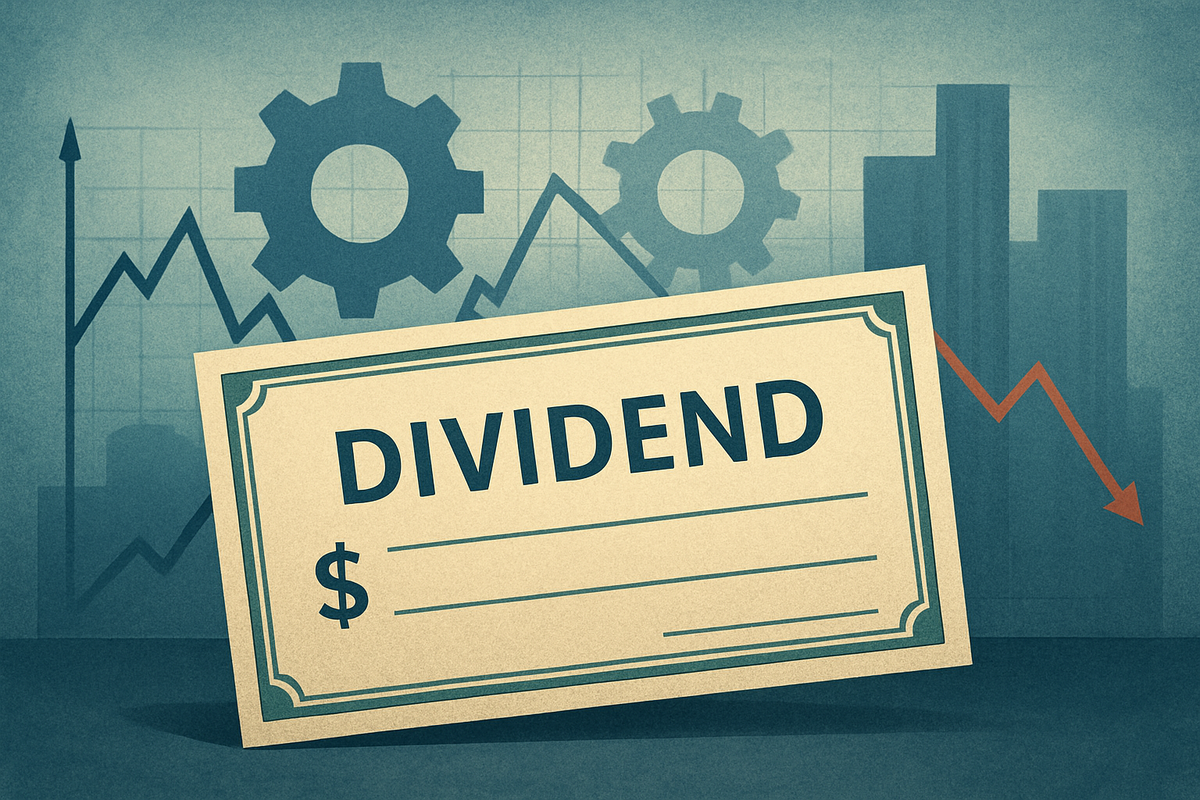Employers Holdings (EIG) Navigates Financial Adjustments with Steadfast Dividend Declaration

Reno, NV – October 30, 2025 – Employers Holdings, Inc. (NYSE: EIG), a leading provider of workers' compensation insurance, has announced a regular quarterly dividend of $0.32 per share, payable on August 27, 2025, to shareholders of record as of August 13, 2025. This declaration comes amidst a period of significant financial adjustments for the company, including a reported net loss in the third quarter of 2025 and strategic moves to bolster its reserves and optimize its capital structure.
The decision to maintain a consistent dividend payout despite recent financial headwinds presents a nuanced signal to the market. While a dividend declaration typically signifies management confidence in future profitability, the backdrop of a net loss and ongoing financial recalibrations invites closer scrutiny from investors and analysts alike regarding the sustainability and strategic intent behind such a move.
Navigating Turbulence: EIG's Dividend Amidst Strategic Shifts
Employers Holdings (NYSE: EIG) formally declared its regular quarterly cash dividend of $0.32 per share on July 30, 2025. This dividend is scheduled to be paid on August 27, 2025, to shareholders who are on record as of the ex-dividend and record date of August 13, 2025. The announcement follows a challenging third quarter for 2025, in which the company reported a net loss of $8.3 million. This loss prompted the company to undertake substantial actions aimed at strengthening its reserves, particularly in response to an increase in California cumulative trauma claims, which have impacted the workers' compensation sector.
In a broader strategic maneuver, Employers Holdings (NYSE: EIG) also approved a significant $125 million increase to its existing share repurchase program. This initiative is intended to be funded through various debt sources as part of a comprehensive recapitalization plan. The stated goals of this plan are to optimize the company's capital structure, reduce its overall cost of capital, and ultimately enhance shareholder value. Despite the reported net loss, the company did observe some positive operational trends, including a 1% increase in gross premiums written and a 3% rise in net premiums earned during the third quarter of 2025. However, earlier in the second quarter of 2025, the company experienced a 2% decrease in net income per diluted share and a more pronounced 56% decline in adjusted net income per diluted share, with the GAAP combined ratio worsening from 94.2% to 105.6%. Key stakeholders in this decision include the company's board of directors, management team, and its extensive base of public shareholders who rely on consistent returns.
The initial market reaction to such declarations, especially within a context of financial adjustments, is often a mixed bag. While the maintenance of a dividend can be seen as a strong vote of confidence from management in the company's long-term health and a commitment to shareholder returns, it can also raise questions about the prudence of capital allocation if earnings are under pressure. The concurrent announcement of a debt-funded share repurchase program further complicates the narrative, as investors weigh the potential for enhanced shareholder value against the implications of increased leverage.
Implications for Investors and the Competitive Landscape
For current and prospective investors in Employers Holdings (NYSE: EIG), the dividend declaration during a period of financial adjustment presents a complex scenario. Income-focused investors may view the maintained $0.32 per share dividend positively, as it signals a continued commitment to returning capital despite a reported net loss. This could help retain a segment of the investor base that prioritizes regular payouts. However, growth-oriented investors and those concerned with long-term financial stability might scrutinize the sustainability of this dividend, especially given the historical payout ratio and the recent decline in earnings. With an annual dividend of $1.24 against a past year's earnings per share of $0.48, the dividend's coverage by current earnings appears strained, potentially raising red flags regarding future flexibility.
The concurrent increase in the share repurchase program, funded by debt, is designed to optimize capital structure and boost shareholder value by reducing the number of outstanding shares. If successful, this could lead to higher earnings per share in the future and potentially a higher stock valuation. However, the use of debt for repurchases also increases financial leverage, adding a layer of risk. Should the recapitalization plan not yield the desired improvements in capital cost or should the market environment deteriorate, EIG's financial flexibility could be constrained. The success of these initiatives hinges on EIG's ability to effectively manage its reserves and improve underwriting profitability in the coming quarters.
From a competitive standpoint, other players in the workers' compensation insurance market, such as Travelers Companies (NYSE: TRV) or Hartford Financial Services Group (NYSE: HIG), will likely observe EIG's strategy closely. While a single dividend declaration by a competitor typically doesn't cause immediate ripple effects across an entire industry, EIG's broader recapitalization strategy and its approach to managing reserves in a challenging claims environment could set a precedent or influence competitive positioning. If EIG's strategy effectively stabilizes its financial position and enhances shareholder value, it might encourage similar capital management approaches by peers facing comparable pressures. Conversely, if the strategy proves overly aggressive or unsustainable, it could serve as a cautionary tale.
Wider Significance: Capital Management in a Shifting Market
Employers Holdings' (NYSE: EIG) decision to maintain its dividend and expand its share repurchase program amid financial adjustments reflects broader trends in capital management within the insurance industry, particularly for companies navigating challenging underwriting cycles. In an environment characterized by increasing claims costs, such as the California cumulative trauma claims EIG is addressing, and fluctuating investment returns, insurers are under pressure to demonstrate financial resilience while still delivering shareholder value. EIG's strategy highlights a common dilemma: how to balance the need to strengthen reserves and maintain solvency with the desire to reward shareholders.
Historically, dividend signaling has been a powerful tool for corporate management. Maintaining a dividend, even during periods of reported losses, can be interpreted as a strong signal of confidence in the company's underlying business model and its ability to weather short-term storms. This aligns with the "dividend signaling hypothesis," where consistent payouts are seen as an indicator of management's positive outlook on future cash flows. However, this strategy is not without risk. If the financial adjustments prove more protracted or severe than anticipated, the continued dividend could become unsustainable, leading to a potential cut that would likely be met with a far more negative market reaction.
The regulatory implications of EIG's reserve strengthening actions, particularly concerning California claims, are significant. Insurance regulators closely monitor reserve adequacy to ensure policyholder protection. EIG's proactive steps to bolster reserves, while impacting profitability in the short term, are crucial for long-term stability and regulatory compliance. The debt-funded share repurchase program, while aimed at capital optimization, will also be scrutinized for its impact on the company's solvency ratios and overall financial health. This event underscores the delicate balance insurers must strike between satisfying shareholder demands and adhering to stringent regulatory requirements designed to protect policyholders.
What Comes Next: Navigating the Path Ahead
In the short term, the market will closely monitor Employers Holdings' (NYSE: EIG) execution of its recapitalization plan and its ability to stabilize underwriting performance. Investors will be keen to see if the debt-funded share repurchases genuinely lead to an optimized capital structure and a reduction in the cost of capital, as intended. The company's upcoming quarterly earnings reports will be critical in assessing whether the reserve strengthening actions are sufficient and if the underlying business, particularly premium growth and claims management, is improving. Any further deterioration in financial results could put pressure on the sustained dividend, potentially forcing a strategic pivot.
Looking further ahead, the long-term success of EIG's strategy hinges on its capacity to generate consistent, profitable growth and manage its claims exposure effectively, especially in high-cost regions like California. The company will need to demonstrate that its "financial adjustments" are indeed temporary and that its core business remains robust. Potential strategic adaptations could include further refinement of its underwriting practices, exploration of new markets, or even a re-evaluation of its capital allocation strategy if market conditions or internal performance warrant.
Market opportunities for EIG could emerge if its recapitalization plan successfully enhances shareholder value and its operational improvements lead to increased profitability and a stronger balance sheet. This could attract new institutional investors and improve its standing among analysts. Conversely, challenges include the ongoing pressure from claims inflation, competitive pricing in the workers' compensation market, and the inherent risks associated with increased financial leverage. Potential scenarios range from a successful turnaround that validates management's confidence to a more prolonged period of financial strain that necessitates more drastic measures.
Wrap-Up: A Strategic Gamble in Challenging Times
Employers Holdings' (NYSE: EIG) decision to declare a regular quarterly dividend of $0.32 per share amidst a reported net loss and significant financial adjustments is a clear signal of management's confidence in the company's long-term prospects and its commitment to shareholder returns. This move, coupled with an increased debt-funded share repurchase program, represents a strategic gamble aimed at optimizing capital structure and enhancing per-share value, even as the company grapples with reserve strengthening and challenging underwriting conditions.
Moving forward, the market will primarily assess EIG based on its ability to execute its recapitalization plan, improve its underwriting profitability, and demonstrate the sustainability of its dividend. The coming months will be crucial for the company to show tangible progress on these fronts. Investors should closely watch for future earnings reports, updates on the share repurchase program's impact, and any further commentary from management regarding the effectiveness of their financial adjustments and reserve adequacy. The ultimate significance and lasting impact of this decision will be measured by EIG's ability to emerge from this period of adjustment with a stronger, more resilient financial foundation.
This content is intended for informational purposes only and is not financial advice



